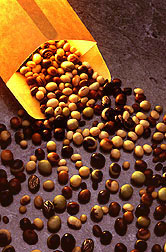This page has been archived and is being provided for reference purposes only. The page is no longer being updated, and therefore, links on the page may be invalid.
USDA Launches Database of Beneficial Compounds in Soy Foods
By Judy McBride
April 7, 1999
WASHINGTON, April 7--A new U.S. Department of Agriculture database launched today on the World Wide Web will help scientists pinpoint which estrogen-like compounds—isoflavones—in soy foods may be responsible for a lower risk of cancer, especially breast cancer.
"Some of these estrogen-like compounds have been reported to benefit the cardiovascular system or to reduce bone loss after menopause," said Agriculture Secretary Dan Glickman. "So, the new database could help nutritionists and physicians. They'll be better equipped to recommend foods with the highest levels of specific compounds."
Scientists with USDA's Agricultural Research Service compiled the database. It gives values for the major isoflavones in 128 soy foods and ingredients, said lead scientists Gary Beecher and Joanne Holden at ARS' Beltsville Human Nutrition Research Center in Beltsville and Riverdale, Md.
Isoflavones, such as daidzein, genistein and glycitein mimic the hormone estrogen. "They also have antioxidant capability," Beecher said, "and may perform other functions that enhance health."
Commercial products were analyzed to arrive at isoflavone values for some types of foods or food additives. The database gives isoflavone values for some individual brand names. The new soy isoflavone database can be found on the web at:
http://www.nal.usda.gov/fnic/foodcomp/Data/isoflav/isoflav.html
In assembling the database, Beecher, with the Food Composition Laboratory, and Holden and colleagues Seema Bhagwat and David Haytowitz with the Nutrient Data Laboratory evaluated and compiled some 30 scientific reports of the isoflavone content of foods. They relied heavily on analyses by collaborator Patricia Murphy at Iowa State University in Ames.
The database springs from a larger effort by the ARS researchers to compile information on health-enhancing phytonutrients in foods. It follows on the heels of an database of carotenoids--such as beta and alpha carotene, lycopene and lutein--in 215 foods. That database was launched last fall.
Future plans include a database for food flavonoids, such as catechins in tea, naringin and taxifolin in citrus and quercitin in onions, apples and red wine.
Scientific contact: Gary Beecher, Food Composition Laboratory, or David Haytowitz, Nutrient Data Laboratory, ARS Beltsville Human Nutrition Research Center, Beltsville, Md. Beecher: phone (301) 504-8356, fax (301) 504-8314, beecher@bhnrc.usda.gov. Haytowitz: phone (301) 734-5635, fax (301) 734-8498, dhaytowitz@rbhnrc.usda.gov.

